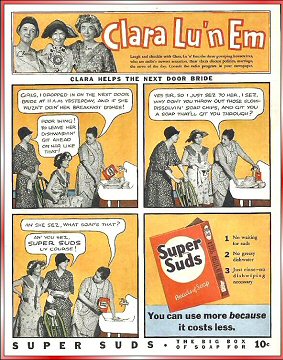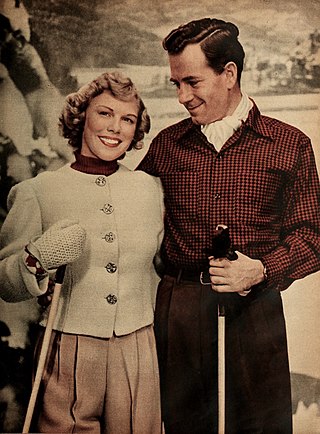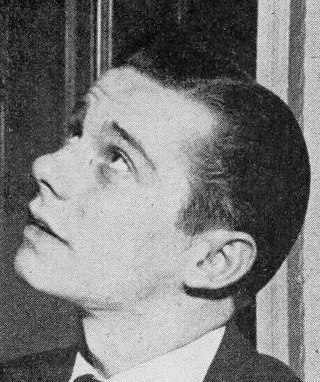
Ma Perkins is an American radio soap opera that was heard on NBC from 1933 to 1949 and on CBS from 1942 to 1960. It was also broadcast in Canada, and Radio Luxembourg carried it in Europe.

The Romance of Helen Trent was a radio soap opera which aired on CBS from October 30, 1933 to June 24, 1960 for a total of 7,222 episodes. The show was created by Frank and Anne Hummert, who were among the most prolific producers during the radio soap era.

Anne Hummert was the leading creator of daytime radio serials or soap opera dramas during the 1930s and 1940s, responsible for more than three dozen series.
Just Plain Bill was a 1932-1955 15-minute American radio drama program heard on CBS Radio and NBC Radio. It was "a story of people just like people we all know."
Amanda of Honeymoon Hill is a 15-minute daily radio soap opera produced by Frank and Anne Hummert. Broadway actress Joy Hathaway had the title role, sometimes described as "the beauty of flaming red hair." The series was broadcast from February 5, 1940, until April 26, 1946, initially on the Blue Network at 3:15 p.m. until August 1942. It then moved to CBS, airing at 10:30 a.m. until 1943 when it was heard at 11 a.m.

Clara, Lu, 'n Em is a radio soap opera, which first aired on June 16, 1930, over WGN-AM Chicago, Illinois. The show was picked up by the NBC Blue radio network and premiered at 10:30 p.m. Eastern Time on January 27, 1931. Thus, it became the first nationally broadcast radio soap opera. When Clara, Lu 'n Em was moved to a regular daytime time slot on February 15, 1932, it became the first networked daytime soap opera.

Lorenzo Jones was a daytime radio series which aired on NBC in different timeslots over an 18-year span.

Our Gal Sunday is an American soap opera produced by Frank and Anne Hummert, network broadcast via CBS from March 29, 1937, to January 2, 1959, starring Dorothy Lowell and, after Lowell's 1944 death, Vivian Smolen in the title role.
Second Husband is an American radio soap opera that aired from 1936 to 1946.
Kitty Foyle is an American old-time radio and television soap opera originally aired during the 1940s and 1950s that was based on the 1940 film of the same name starring Ginger Rogers. Kitty Foyle was created by soap opera mogul Irna Phillips of Guiding Light fame and produced by daytime radio monarchs Frank and Anne Hummert of Helen Trent recognition. The program originally starred Julie Stevens in the title role of Kitty Foyle on radio. On television, the title role was portrayed by Kathleen Murray.
Edward Frank Hummert, Jr., professionally known as Frank Hummert and sometimes credited as E. Frank Hummert, was an American advertising agent originally but was best known for writing/producing episodes of nearly 100 daytime/primetime radio dramas and soap opera serials between the 1930s and the 1950s.
Betty and Bob is a radio soap opera. The soap opera follows the lives of Betty and Bob Drake. Betty was a secretary who falls madly in love with her boss, bachelor Bob Drake. The two wed and each day, the subject matter dealt with everything from love to hate, jealousy to divorce, murder to betrayal, and collusion to insanity.
Skippy was an American children's radio serial based on the popularity of the comic strip Skippy. It was broadcast on CBS Radio from January 11, 1932 to March 29, 1935.

Elizabeth Wragge was an actress who appeared on more than 10,000 old-time radio programs in addition to working in other media. She was sometimes billed as Elizabeth Wragge.

Front Page Farrell is an American old-time radio program that was broadcast on Mutual from June 23, 1941 to March 13, 1942, and on NBC from September 14, 1942, to March 26, 1954. The episodes broadcast on Mutual originated at WOR, making the program the first live serial that Mutual broadcast from New York City.

John's Other Wife is an American old-time radio soap opera. It was broadcast on NBC-Red from September 14, 1936, until March 1940. In that month it moved to NBC-Blue, where it ran until March 20, 1942.

Bob Readick, also known professionally as Bobby Readick, was an American voice and film actor, best known for a run as the voice of "Johnny Dollar" in the CBS radio series Yours Truly, Johnny Dollar in the early 1960s.

The Story of Mary Marlin is an American soap opera radio program. It was broadcast from October 3, 1934, until April 12, 1945, and returned from September 24, 1951, until April 11, 1952. After 1937 it was among the highest-rated soap operas. A version was also broadcast in Australia in 1959-1960.
Arnold Grimm's Daughter is an American radio soap opera that was broadcast from July 5, 1937, until June 26, 1942, first on CBS and later on NBC.
Mr. Chameleon is a detective fiction radio drama created by Frank Hummert and produced by Frank and Anne Hummert. It ran on CBS Radio from July 14, 1948, to 1951 or 1953. The series starred Karl Swenson as a New York police detective who is a master of disguise, and who assumes a new identity in each episode in order to catch a criminal. The listening audience is always aware of who Mr. Chameleon is, no matter in which disguise he appears. According to the series' opening voice-over, "Chameleon" is not a nickname or pseudonym but the character's actual surname, one which he has tried to live up to since childhood. His motto is, "The innocent must be protected and the guilty must be punished." The theme song is John Jacob Loeb and Paul Francis Webster's "Masquerade".











